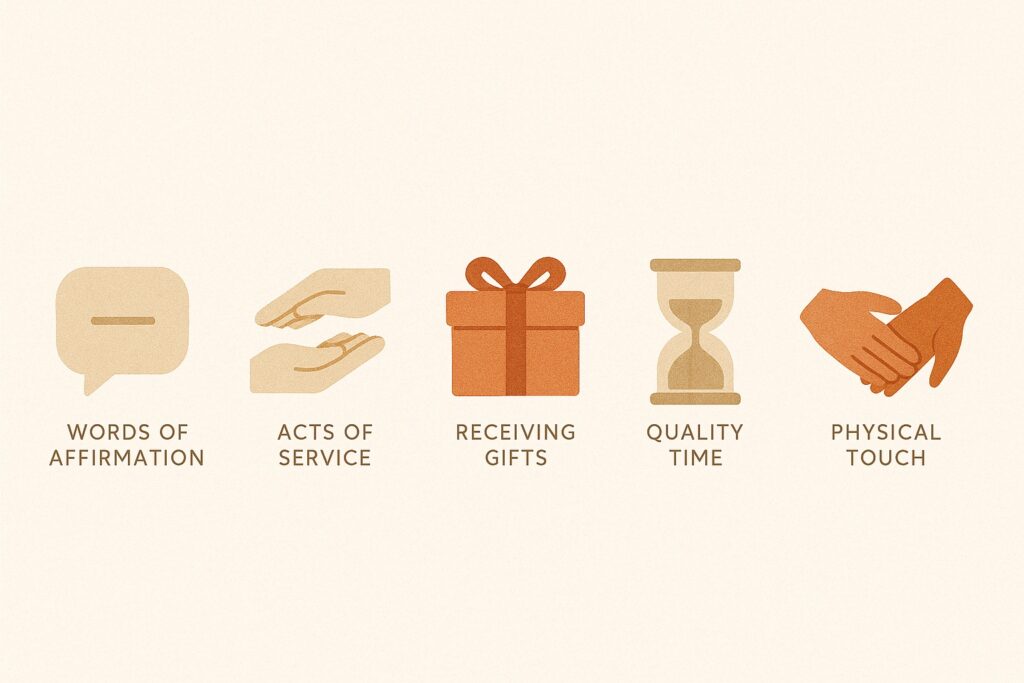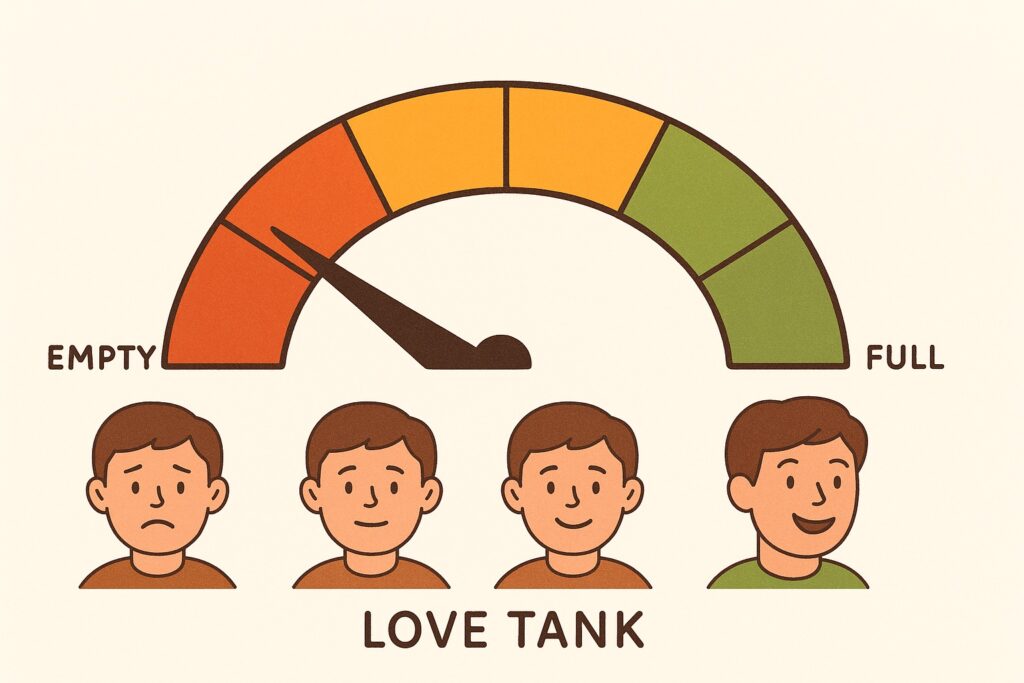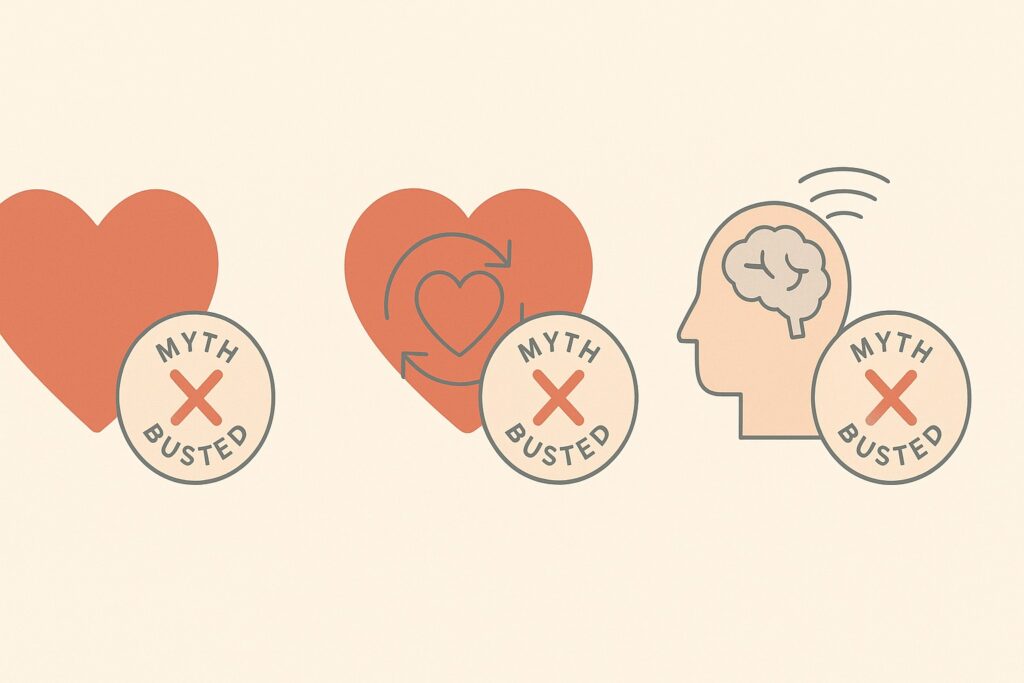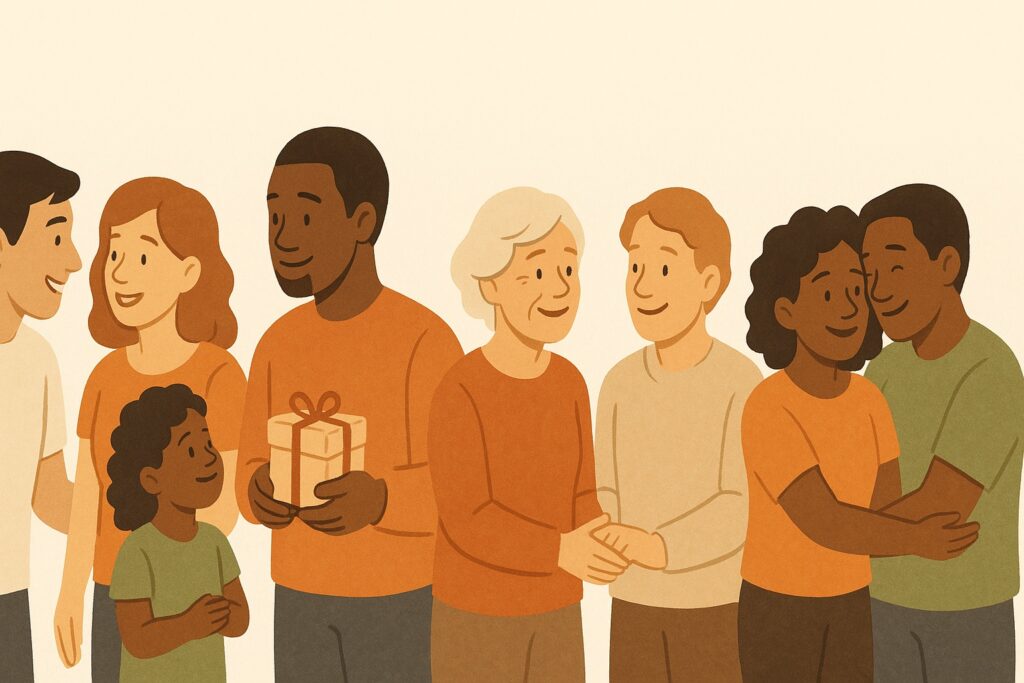The 5 Love Languages Explained: A Guide to Understanding How We Give and Receive Love
The 5 Love Languages Explained: How We Give and Receive Love (2025)

“I just don’t feel loved anymore.”
These words echo in countless relationships — not because love is absent, but because it’s being expressed in ways that go unrecognized. You might be showering your partner with compliments while they’re silently wishing you’d just help with the dishes. Or perhaps you’re working overtime to buy thoughtful gifts when your partner simply craves uninterrupted conversation.
This disconnect isn’t about a lack of love — it’s about speaking different love languages.
What Are the 5 Love Languages?

The concept of love languages was developed by Dr. Gary Chapman, a marriage counselor who observed that people tend to express and receive love in five primary ways. After years of counseling couples, Dr. Chapman published “The 5 Love Languages: The Secret to Love That Lasts” in 1992, introducing a framework that has since helped millions understand the diverse ways love can be communicated.
The five love languages are:
- Words of Affirmation: Expressing affection through spoken or written words, praise, or appreciation
- Acts of Service: Actions that require thought, planning, time, effort, and energy
- Receiving Gifts: Giving thoughtful or meaningful items that show you understand and value the recipient
- Quality Time: Giving someone your undivided attention
- Physical Touch: Expressing affection through physical contact
Understanding these five distinct expressions of love isn’t just helpful — it’s transformative. When we recognize our own primary love language and those of the people we care about, we gain a roadmap for more meaningful connection.
Why Love Languages Matter: The Love Tank Concept

At the core of the love languages philosophy is the concept of a “love tank” — an emotional reservoir within each of us that needs to be regularly filled with expressions of love that resonate personally. When our love tank is full, we feel secure, valued, and connected. When it’s empty, relationships often suffer.
What makes the love languages framework so powerful is its focus on the recipient’s preferences rather than the giver’s natural tendencies. Love becomes not just about intention (“I meant to show I care”) but about impact (“You truly made me feel loved”).
As Dr. Chapman explains: “People tend to criticize their spouse most loudly in the area where they themselves have the deepest emotional need.” This insight reveals why relationship friction often happens — we give love the way we want to receive it, then feel hurt when that approach doesn’t resonate with our partner.
A Deeper Look at Each Love Language
Let’s explore each love language in depth, with practical examples of how they appear in everyday life:
Words of Affirmation

For those whose primary love language is Words of Affirmation, nothing speaks more deeply than hearing “I love you,” “I’m proud of you,” or “I appreciate what you did.” Verbal compliments, encouragement, kind words, and frequent expressions of affection fill their love tank quickly.
Real-world examples:
- Sending unexpected texts of appreciation
- Leaving notes of encouragement
- Acknowledging efforts, even when results aren’t perfect
- Expressing gratitude for specific actions
- Offering genuine compliments about character, not just appearance
When Words of Affirmation are missing: A person with this love language may feel unappreciated despite other expressions of love. They might say, “You never tell me you love me anymore” even if you show love in other ways.
Acts of Service

For some, actions speak louder than words. Those with Acts of Service as their primary love language feel most loved when their partner actively does things to ease their burden or make their life easier. It’s about noticing what would help and taking initiative without being asked.
Real-world examples:
- Preparing meals when they’re busy
- Taking care of chores they normally handle
- Running errands to save them time
- Fixing something that’s been bothering them
- Helping with a project without being asked
When Acts of Service are missing: People with this love language may feel neglected or that their needs aren’t important, even if they receive verbal affirmation or gifts. They might think, “If you really loved me, you’d help me with this.”
Receiving Gifts

This love language isn’t about materialism but symbolism. For those who value Receiving Gifts, a thoughtful present signifies that they were seen, known, and thought about. The perfect gift communicates “I understand you” and “You matter to me” in a tangible form.
Real-world examples:
- Bringing home their favorite treat after a tough day
- Remembering something they mentioned wanting months ago
- Creating handmade items that reflect personal significance
- Finding something that perfectly suits their interests
- Giving small tokens of affection throughout the year, not just on special occasions
When Receiving Gifts is missing: Those with this love language may feel forgotten or unvalued when birthdays or anniversaries pass without thoughtful gifts, even if they receive other forms of love.
Quality Time

In our distraction-filled world, giving someone your full, undivided attention is a powerful expression of love. For those whose primary language is Quality Time, being fully present and engaged speaks volumes about their importance in your life.
Real-world examples:
- Having regular conversations without phones or screens
- Participating in activities they enjoy, even if they’re not your favorite
- Planning date nights or special outings regularly
- Creating rituals of connection (morning coffee together, evening walks)
- Actively listening without planning your response or solving their problems
When Quality Time is missing: People with this love language may feel lonely within the relationship or believe they’re a low priority, even if they receive gifts or words of affirmation.
Physical Touch

For those who speak the language of Physical Touch, appropriate physical connection and expressions of affection are crucial. This doesn’t necessarily mean sexual intimacy but includes all forms of physical connection that communicate care.
Real-world examples:
- Holding hands while walking
- Offering a back rub after a stressful day
- Sitting close on the couch during movie night
- Greeting with a hug or kiss
- Comforting with an embrace during difficult times
When Physical Touch is missing: Those with this love language may feel unloved or disconnected without regular physical affection, even if their partner is verbally affirming or performs acts of service.
Beyond Romantic Relationships
While often applied to romantic partnerships, love languages extend far beyond that context. They’re equally relevant in:
- Parent-child relationships: Children have love languages too, and recognizing them can strengthen family bonds
- Friendships: Understanding how your friends experience love can deepen connections
- Professional settings: Managers who recognize different “appreciation languages” often have more engaged teams
- Self-love: Identifying your own love language can help you practice self-care more effectively
The framework offers insights for any relationship where emotional connection matters—which is to say, all human relationships.
Common Misconceptions About Love Languages

Despite the concept’s popularity, several misconceptions persist that can limit its effectiveness:
Misconception #1: “I have only one love language”
Reality: While most people have a primary and secondary love language, we all appreciate all five languages to varying degrees. Your love language profile is more like a fingerprint than a single category.
Misconception #2: “Love languages never change”
Reality: Your primary love language likely remains fairly consistent throughout life, but life circumstances, personal growth, and healing from past wounds can shift how you prefer to receive love.
Misconception #3: “My partner should just know my love language”
Reality: Even the most attentive partners aren’t mind readers. Open communication about preferences is essential for any love language to work effectively.
Misconception #4: “The love languages concept is scientifically proven”
Reality: While widely applied in relationship counseling, the concept stems from Dr. Chapman’s observations rather than rigorous scientific study. Though research has begun to explore and validate aspects of the framework, it’s best viewed as a helpful tool rather than a psychological law.
Misconception #5: “Speaking someone’s love language will fix all relationship problems”
Reality: Love languages facilitate better communication and connection, but they don’t address all relationship challenges like trust issues, incompatible values, or unhealthy patterns.
Discovering Your Love Language: Beyond the Quiz

While taking our love language quiz is an excellent starting point, deeper self-reflection can provide additional insights:
- Observe your requests: What do you ask for most often from your partner or loved ones?
- Note your complaints: What disappoints you or makes you feel unloved?
- Identify your giving patterns: We often give love in ways we’d like to receive it.
- Reflect on past joy: When have you felt most loved? What specifically created that feeling?
- Consider your love history: Sometimes our love language is shaped by what we lacked growing up.
Remember that discovering your love language isn’t about boxing yourself in—it’s about gaining clarity that helps you communicate your needs more effectively.
When Love Languages Differ: Bridging the Gap

Perhaps the greatest challenge—and opportunity—arises when partners have different primary love languages. Here are strategies for navigating this common scenario:
- Recognize the legitimacy of differences: Neither love language is “better” or more valid than the other.
- Learn to speak their language: Make deliberate efforts to express love in ways your partner best receives it.
- Teach your preferred language: Gently educate your partner about actions that make you feel most loved.
- Acknowledge efforts: Appreciate attempts to speak your language, even when execution isn’t perfect.
- Create reminders: Keep notes of your loved ones’ preferences visible until showing love in their language becomes second nature.
The goal isn’t to abandon your natural way of giving love but to become bilingual—fluent in both your native love language and the language of those you care about.
Love Languages and Healthy Boundaries
An important consideration often overlooked in discussions of love languages is the role of healthy boundaries. Understanding love languages should never become a tool for manipulation or control.
Signs of unhealthy expressions include:
- Demanding proof of affection (“If you loved me, you’d…”)
- Using guilt to receive expressions of love
- Creating transactional expectations
- Using someone’s love language to isolate them
- Dismissing or criticizing sincere efforts to show love
Healthy love language expression always includes respect for both people’s needs, preferences, and boundaries.
The Evolution of Love Languages: Research and Critiques
As with any framework for understanding human behavior, the love languages concept has both strengths and limitations. Ongoing research continues to explore how well the model aligns with attachment theory, cultural differences in emotional expression, and neurodiversity considerations.
Some academics propose additional languages, such as shared experiences or emotional vulnerability. Others question the lack of rigorous validation studies. These critiques don’t invalidate the usefulness of the framework but remind us to apply it as one tool among many for understanding relationships.
Applying Love Languages in Daily Life: A Sample Week
Transforming love language knowledge into practice can be simple yet profound. Here’s a sample weekly plan for incorporating love languages into a relationship:
Monday: Set aside 20 minutes of distraction-free Quality Time for conversation.
Tuesday: Write a specific Words of Affirmation note highlighting something you appreciate.
Wednesday: Perform an Act of Service without being asked.
Thursday: Find a small, meaningful Gift that shows thoughtfulness rather than expense.
Friday: Increase Physical Touch through intentional hugs, hand-holding, or other appropriate contact.
Weekend: Reflect together on which expressions felt most meaningful and why.
This simple rotation ensures all languages are practiced regularly, even if some aren’t your partner’s primary language.
Conclusion: Love Languages as a Lifelong Practice

Understanding love languages isn’t a one-time revelation but a lifelong practice of learning to love others in ways that truly resonate with them. The framework offers a practical vocabulary for expressing needs, showing appreciation, and deepening connections across all relationships.
The most powerful aspect of love languages might be their reminder that love is both a feeling and a choice—a commitment to continuously learn and adapt how we express care for the important people in our lives.
As you continue exploring this concept, remember that the goal isn’t perfect execution but greater understanding and more meaningful connection. Love languages aren’t about performance but presence—being attentive enough to notice what makes others feel genuinely loved.
Ready to Discover Your Love Language?
Our comprehensive love language quiz can help you identify your primary and secondary languages, offering personalized insights to enhance your relationships. Take the first step toward more meaningful connections by discovering your unique love language profile today.
Take the Love Language Quiz Now
Have questions about how love languages apply to your specific relationship challenges? Explore our blog for deeper insights on navigating differences, expressing love authentically, and building stronger connections through understanding.


Hi, this is a comment.
To get started with moderating, editing, and deleting comments, please visit the Comments screen in the dashboard.
Commenter avatars come from Gravatar.
[…] most people think of love languages as something that applies only to romantic relationships, they’re equally powerful in […]